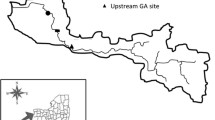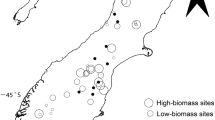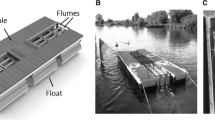Abstract
While the consequences of bioinvasions are becoming clearer, our understanding of the environmental and ecological factors driving them is limited due to the complexity of the invasion process. Invasion success can be considered to be influenced by characteristics of the receiving assemblage (habitat, food, community interactions) and disturbances. Studies on the effects of the receiving assemblage have typically focused on a single or small subset of species, rather than on complex, multitrophic assemblages. We used an experimental assemblage consisting of more than 30 taxa from multiple trophic levels to evaluate the importance of the presence of this community and disturbance on colonisation by a generalist invader. To achieve this, we compared colonisation between a disturbed and undisturbed community. In addition, we evaluated the effects of the presence of organic matter of a different source (simulating a disturbance event affecting different habitats) on colonisation. A model generalist invader, the isopod Cirolana harfordi, was introduced to patches of oyster beds with (1) undisturbed (live) assemblages, (2) disturbed assemblages, (3) organic matter (using organic matter of a different source), or (4) no assemblage or organic matter. Our results indicated that the presence of an assemblage (disturbed or not) fostered colonisation; however, colonisation was less successful when the assemblage was undisturbed. Results also indicate that for a disturbance event to affect the colonisation of C. harfordi, it has to directly affect the invaded assemblage. These results add to the understanding of the factors driving invasions, which is important to design management strategies.




Similar content being viewed by others
References
Alpert P, Bone E, Holzapfel C (2000) Invasiveness, invasibility and the role of environmental stress in the spread of non-native plants. Perspect Plant Ecol Ecol Syst 3:52–66
Altieri AH, van Wesenbeeck BK, Bertness MD, Silliman BR (2010) Facilitation cascade drives positive relationship between native biodiversity and invasion success. Ecology 91:1269–1275
Anderson MJ (2001) A new method for non parametric multivariate analysis of variance. Aust Ecol 26:32–46
Anderson MJ, Robinson J (2003) Generalized discriminant analysis based on distances. Aust NZ J Stat 45:301–318
Australian Museum Business Services (2002) Port survey for introduced marine species—Sydney Harbour. Sydney Ports Corporation, Sydney, p 71
Bates D, Maechler M, Bolker B, Walker S (2014) lme4: Linear mixed-effects models using Eigen and S4. http://CRANR-projectorg/package=lme4
Brandt CA, Rickard WH (1994) Alien taxa in the North American shrub-steppe four decades after cessation of livestock grazing and cultivation agriculture. Biol Conserv 68:95–105
Bruno JF, Stachowicz JJ, Bertness MD (2003) Inclusion of facilitation into ecological theory. Trends Ecol Evol 18:119–125
Bugnot AB (2014) Associations between benthic communities and an invasive isopod. School of Biological Sciences, The University of Sydney, Sydney, p 184
Bugnot AB, Coleman RA, Figueira WF, Marzinelli EM (2014) Patterns of the non-indigenous isopod Cirolana harfordi in Sydney Harbour. PLoS One 9:e86765
Bugnot AB, Coleman RA, Figueira WF, Marzinelli EM (2015) Community-level impacts of the invasive isopod Cirolana harfordi. Biol Invasions 17:1149–1161
Bunting D (2011) Ecology, genetics and habitat use of the potentially invasive isopod Cirolana harfordi. School of Biological Sciences, The University of Sydney, Sydney, p 219
Byers JE (2002) Impact of non-indigenous species on natives enhanced by anthropogenic alteration of selection regimes. Oikos 97:449–458
Carlton JT (2009) Deep invasion ecology and the assembly of communities in historical time. In: Rilov JA, Crooks JA (eds) Biological invasions in marine ecosystems: ecological, management and geographic perspectives. Springer, Berlin, pp 13–56
Case TJ (1990) Invasion resistance arises in strongly interacting species-rich model competition communities. Proc Natl Acad Sci 87:9610–9614
Chapman M (1998) Relationships between spatial patterns of benthic assemblages in a mangrove forest using different levels of taxonomic resolution. Mar Ecol Prog Ser 162:71–78
Clark GF, Johnston EL (2011) Temporal change in the diversity–invasibility relationship in the presence of a disturbance regime. Ecol Lett 14:52–57
Clarke K, Gorley R (2006) Primer V6: user manual/tutorial. Primer-E Ltd, Plymouth
Crooks JA (2005) Lag times and exotic species: the ecology and management of biological invasions in slow-motion. Écoscience 12:316–329
Davis MA, Grime JP, Thompson K (2000) Fluctuating resources in plant communities: a general theory of invasibility. J Ecol 88:528–534
Doherty TS, Dickman CR, Nimmo DG, Ritchie EG (2015) Multiple threats, or multiplying the threats? Interactions between invasive predators and other ecological disturbances. Biol Conserv 190:60–68
Dunstan PK, Johnson CR (2003) Invasion rates increase with species richness in a marine epibenthic community by two mechanisms. Oecologia 138:285–292
Elton C (1958) The ecology of invasions by animals and plants. Methue, London, p 180
Hewatt W (1937) Ecological studies on selected marine intertidal communities of Monterey Bay, California. Am Midl Nat 18:161–206
Hothorn T, Bretz F, Westfall P (2008) Simultaneous inference in general parametric models. Biom J 50:519–528
Jackson A (2009) Biogenic habitat on artificial structures: consequences for an intertidal predator. Mar Freshw Res 60:519–528
Jackson MC, Allen R, Pegg J, Britton JR (2013) Do trophic subsidies affect the outcome of introductions of a non-native freshwater fish? Freshw Biol 58:2144–2153
Johnson WS (1976) Biology and population dynamics of the intertidal isopod Cirolana harfordi. Mar Biol 36:343–350
Levine JM, Adler PB, Yelenik SG (2004) A meta-analysis of biotic resistance to exotic plant invasions. Ecol Lett 7:975–989
Lohrer AM, Fukui Y, Wada K, Whitlatch RB (2000) Structural complexity and vertical zonation of intertidal crabs, with focus on habitat requirements of the invasive Asian shore crab, Hemigrapsus sanguineus (de Haan). J Exp Mar Biol Ecol 244:203–217
Lozon JD, MacIsaac HJ (1997) Biological invasions: are they dependent on disturbance? Environ Rev 5:131–144
Luczak C, Janquin M-A, Kupka A (1997) Simple standard procedure for the routine determination of organic matter in marine sediment. Hydrobiologia 345:87–94
Martínez-Lendech N, Córdoba-Aguilar A, Serrano-Meneses M (2007) Body size and fat reserves as possible predictors of male territorial status and contest outcome in the butterfly Eumaeus toxea Godart (Lepidoptera: lycaenidae). J Ethol 25:195–199
Olden Julian D, Poff NL (2003) Toward a mechanistic understanding and prediction of biotic homogenization. Am Nat 162:442–460
Polis GA, Myers CA, Holt RD (1989) The ecology and evolution of intraguild predation: potential competitors that eat each other. Annu Rev Ecol Syst 20:297–330
Rejmanek M (1989) Invasibility of plant communities. In: Drake G, Mooney HA, Di Castri F, Groves RH, Kruger FJ, Rejmanek M, Williamson M (eds) Biological invasions: a global perspective. Wiley, Chichester, pp 369–388
Rodriguez LF (2006) Can invasive species facilitate native species? Evidence of how, when, and why these impacts occur. Biol Invasions 8:927–939
Sala O, Chapin F III, Armesto J, Berlow E, Bloomfield J, Dirzo R, Huber-Sanwald E, Huenneke L, Jackson R, Kinzig A (2000) Global biodiversity scenarios for the year 2100. Science 287:1770–1774
Sax DF, Gaines SD (2003) Species diversity: from global decreases to local increases. Trends Ecol Evol 18:561–566
Sax DF, Gaines SD, Brown JH (2002) Species invasions exceed extinctions on islands worldwide: a comparative study of plants and birds. Am Nat 160:766–783
Scanes E, Johnston EL, Cole VJ, O'Connor WA, Parker LM, Ross PM (2015) Quantifying native and invasive oyster distributions in an urbanised estuary. Paper presented at the 52nd Australian Marine Science Association (AMSA) annual conference
Shea K, Chesson P (2002) Community ecology theory as a framework for biological invasions. Trends Ecol Evol 17:170–176
Shurin JB (2000) Dispersal limitation, invasion resistance, and the structure of pond zooplankton communities. Ecology 81:3074–3086
Simberloff D (1989) Which insect introductions succeed and which fail? In: Drake JA, Mooney HA, Castri FD, Groves RH, Kruger FJ, Rejmanek M, Williamson M (eds) Biological invasions: a global perspective. Wiley, Chichester, pp 61–76
Simberloff D, Von Holle B (1999) Positive interactions of nonindigenous species: invasional meltdown? Biol Invasions 1:21–32
Stachowicz JJ (2001) Mutualism, facilitation, and the structure of ecological communities. Bioscience 51:235–246
Stachowicz J, Whitlatch R, Osman R (1999) Species diversity and invasion resistance in a marine ecosystem. Science 286:1577
Thomson M (2013) Mouthparts and their setae of the intertidal isopod Cirolana harfordi. J Microsc 252:111–121
Todd BD, Rothermel BB, Reed RN, Luhring TM, Schlatter K, Trenkamp L, Gibbons JW (2008) Habitat alteration increases invasive fire ant abundance to the detriment of amphibians and reptiles. Biol Invasions 10:539–546
Zuur A, Ieno EN, Walker N, Saveliev AA, Smith GM (2009) Mixed effects models and extensions in ecology with R. Statistics for biology and health. Springer, New York, p 574
Acknowledgments
This work was funded by an International Postgraduate Research Scholarship and Sydney Institute of Marine Science Doctoral Fellowship to A. B., and funding from the Centre for Research on Ecological Impacts of Coastal Cities. We thank Rebecca Morris and Marcos Gil for field assistance and Dov Sax for insightful comments. This is contribution number 183 to the Sydney Institute of Marine Science. All applicable institutional and/or national guidelines for the care and use of animals were followed. Collection of animals from the field was done under NSW Fisheries research permit F96/146-7.1-2.
Author information
Authors and Affiliations
Corresponding author
Additional information
Responsible Editor: F. Chan.
Reviewed by Undisclosed experts.
This article is part of the Topical Collection on Invasive Species.
Electronic supplementary material
Below is the link to the electronic supplementary material.
Rights and permissions
About this article
Cite this article
Bugnot, A.B., Coleman, R.A., Figueira, W.F. et al. Effects of the receiving assemblage and disturbance on the colonisation of an invasive species. Mar Biol 163, 155 (2016). https://doi.org/10.1007/s00227-016-2929-4
Received:
Accepted:
Published:
DOI: https://doi.org/10.1007/s00227-016-2929-4




